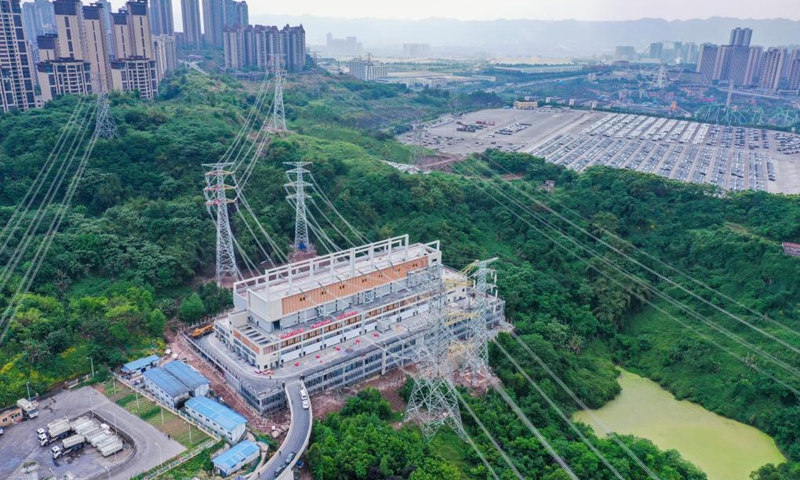China has the ability to fully ensure power supply for households: economic planner

Aerial photo taken on April 27, 2021 shows the view of the 500-KV Jinshan electricity substation in southwest China's Chongqing. The 500-KV Jinshan electricity substation was officially put into operation on Friday, which is expected to greatly improve the power supply in the northern area of Chongqing.Photo:Xinhua
China's top economic planner said on Wednesday that China has the ability to fully ensure power supply for residential use, and announced several measures tackle power shortages in many places around the country, including increasing coal and natural gas imports and production, emphasizing market-based pricing mechanism for thermal power, and making plans to use energy in a sustainable and well-managed manner.
As power shortages continue to draw widespread attention in China, the National Development and Reform Commission (NDRC) said that it will ensure stable energy supply for the upcoming winter and spring to guarantee residential use and heating, according to a post on its official WeChat account.
The NDRC's reassurance came amid growing concerns of power shortages after unexpected and unprecedented power cut in three provinces across Northeast China - Heilongjiang, Jilin and Liaoning - that have resulted in disruptions to daily lives and business operations.
The NDRC said that it will cooperate with relevant authorities in enhancing coordination and prioritizing resources to the Northeast to fully ensure the smooth operation of the energy supply in the region.
China has the ability and capacity to provide full guarantee to power use of households, the NDRC said, noting that residential energy consumption accounts for less than 20 percent of China's total supply, while natural gas for residential use accounts for less than 50 percent of total natural gas consumption.
In a bid to increase power generation and efficiently control the cost amid soaring commodity prices, the NDRC said that it will increase coal and natural gas imports and domestic production, and also promote the signing of medium- to long-term supply contracts for thermal coal.
North China's Shanxi Province has signed medium- to long-term supply contracts of thermal coal for the fourth quarter with 14 provinces and regions on Wednesday, aiming to ensure the coal supply, the Xinhua News Agency reported.
The three provinces in Northeast China recently signed medium- to long-term supply contracts for 6.8 million tons of thermal coal, according to media reports.
Analysts have pointed out that soaring prices and tight supplies of coal are among a confluence of factors behind the power shortages.
Earlier on Wednesday, the NDRC issued a notice, urging relevant authorities, including power suppliers and railway operators across the country, to further strengthen and prioritize the shipment of coal and ensure a stable supply for residential heating ahead of the start of winter.
Industry insiders also noted that soaring costs for power generation and unchanged electricity prices may have also contributed to the power shortages.
Industry insiders told the Global Times that while coal prices continue to rise, electricity prices remain unchanged, discouraging the generation of thermal power.
"Over the years, China's industrial and commercial development has been rapid. Therefore, power consumption has been synchronized. But the power price is relatively low compared with the world," an industry observer surnamed Qi, told the Global Times on Tuesday.
The NDRC introduced a peak electricity pricing mechanism in July, stating that peak price should be at least 20 percent more expensive than the off-peak price. It stressed on Wednesday that a market-based pricing mechanism should be fully implemented.
Meanwhile, the cost of onshore wind power and coal-fired power is about the same now, at about 0.2 yuan ($0.03) per kilowatt-hour, the insiders noted.
Wind power accounts for 60 percent of the total power generation in Northeast China. A recent lack of winds and the closure of many coal-fired power stations to meet the "dual control" goal on total energy consumption and intensity have created a power gap, Sheng Honglei, associate manager of CyberInsight New Energy Technology Co, told the Global Times on Tuesday.
"To make matters worse, heavy industry in Northeast China accounts for a high proportion of energy consumption, which increases power consumption," Sheng said.



